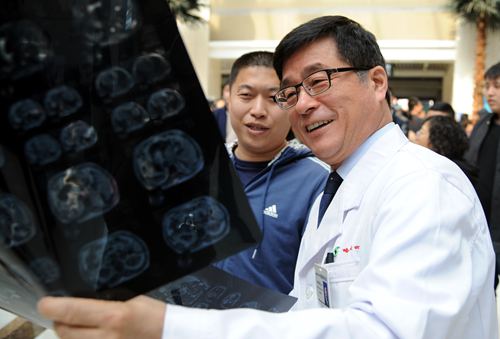|
 |
|
PUT AT EASE: Dr. Shen Baozhong (right) offers a free consultancy at the No.4 Affiliated Hospital to Harbin Medical University in Harbin, northeast China's Heilongjiang Province, on April 17, as part of the 2014 National Promotion Week for Cancer Prevention and Treatment (CFP) |
If Lu Ying, 69, had not had a full body checkup after a car accident in May 1997, he might not have been able to enjoy his retirement today. When he was brought in, doctors discovered that Lu had lesions in his liver, which were diagnosed as cancer.
Today Lu is well enough to take part in 5-km walks and a 90-minute dance session every day with his wife not far away from their home in the coastal city of Yantai, east China's Shandong Province.
"I was in constant fear of the disease. The only thing lingered in my mind was death," Lu recalled.
It was not until radiation therapy and several rounds of surgery that Lu gained confidence in his battle against cancer, he said. "Cancer is certainly not a death sentence, but rather a kind of chronic disease. It took me some time to realize that."
A better understanding
Cancer is a leading cause of death worldwide. According to the World Health Organization (WHO), 8.2 million people died of cancer in 2012. The figure is expected to reach 13 million in the next two decades, while newly diagnosed cases could rise to 22 million annually over the same period, from the present 14 million.
The severe challenges faced by China are in keeping with this trend. Statistics from the National Cancer Prevention and Control Research Office showed about 3.1 million new cases and 2.5 million deaths annually. It is estimated that the figures will hit 6.6 million and 3 million respectively by 2020. Lung, liver and stomach cancers are the biggest three killers in order of frequency in China, while the most frequent types of cancer are lung, breast and stomach.
Cancer survivors like Lu are not rare so long as their condition is detected early, which greatly increases the chances for successful treatment, said Hao Xishan, Chairman of the Chinese Anti-Cancer Association during the 20th National Promotion Week for Cancer Prevention and Treatment that took place from April 15 to 21.
Unfortunately, stereotypes become a major obstacle to cancer prevention. A report on cancer-related beliefs and behaviors released by the International Union Against Cancer in 2009 showed that 43 percent of Chinese nationals surveyed agreed with the statement that "once a person has cancer, not much can be done to cure it." However, only 13 percent of respondents in countries with a higher average income level thought this way.
In Hao's eyes, myths about cancer and its prevention, diagnosis, treatment as well as recovery from it are spread by patients and their relatives, medical professionals, policy makers and even healthy people. Therefore, more education on cancer should be accessible in the community through various channels.
Wu Lingying, chief of the Department of Gynecological Oncology of the Beijing-based Cancer Institute and Hospital (CIH) under the Chinese Academy of Medical Sciences, knows about the myth that "cancer is incurable" better than anyone else.
"Several relatives of mine died of cancer less than six months after diagnosis due to their misconceptions," Wu told Beijing Review.
The good news is that survival rates for some cancers have been on the rise in China in recent years—for instance, the survival rate is over 90 percent for early-stage breast cancer patients, thanks to a higher public awareness, more early detection available and adequate treatment, Wu noted.
Moreover, free screening tests on breast and cervical cancers targeting women aged between 35 and 59 have been gradually promoted nationwide since 2009. Over 13 million women in rural areas received the tests from 2009 to 2011. The rate of early detection for cervical and breast cancers hit 91.7 percent and 69.7 percent, respectively. In Beijing alone, where the program was being piloted, some 2.39 million women had been inspected by the end of 2012, with 2,026 new cases being diagnosed.
"The threat posed by the disease has been exaggerated. That is why cancer patients are more scared than those who suffer other chronic diseases such as late-stage diabetes and heart attacks," explained He Jie, President of CIH and an academician of the Chinese Academy of Sciences.
| 